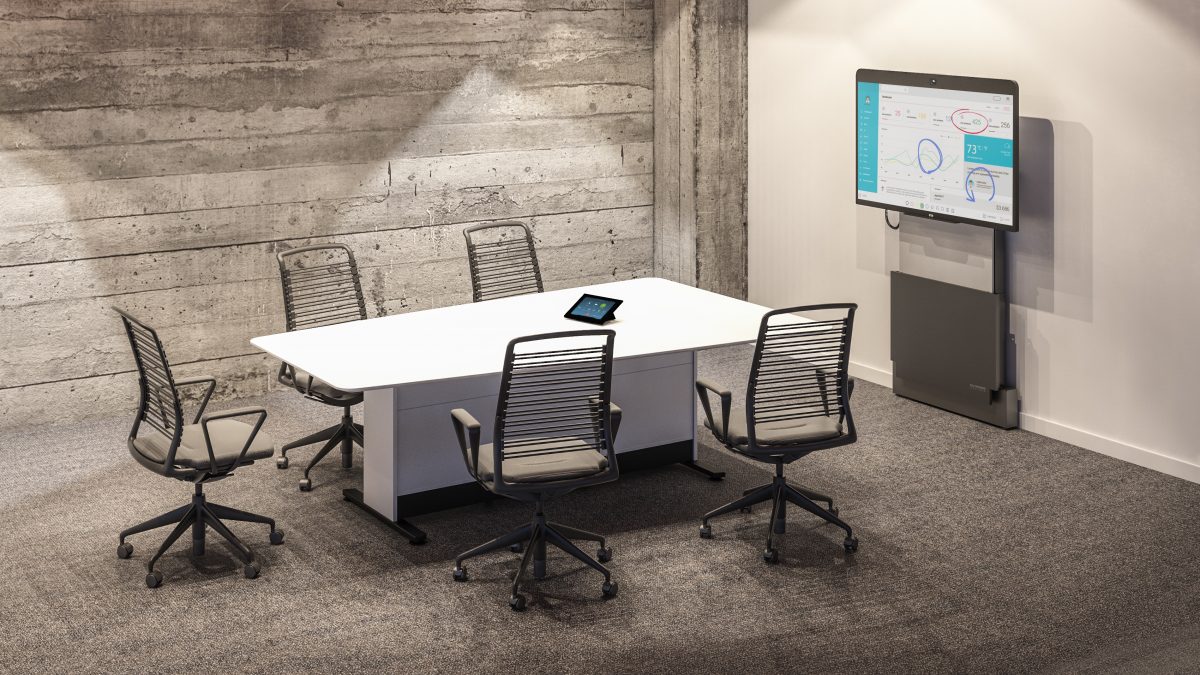Zoom Room Design
Zoom Room Design
Every company that uses Zoom rooms today is looking at designing their conferencing rooms to work and function as a video collaboration space using the Zoom Room software. Zoom Rooms will provide your team and customers with a great space to collaborate with remote participants on a Zoom Meeting or Webinar.
Designing the Audio-Visual hardware for your Zoom Rooms starts with identifying the use cases and functionality of the space. Questions you should ask yourself about the space are:
- What is my existing furniture in the room and what will change about the space over time?
- Will everyone be seated in the room at the table or will people be walking around the room or up at the whiteboard?
- How many people will be in this Zoom Room at one time?
- What are the different camera angles/locations that I need to consider when integrating one or multiple cameras in the space?
- What types of advanced controls will be needed to properly run this space (lighting, shades, projectors, displays, mics, cameras, etc.)?
Zoom Room software allows for flexibility and adaptability to be custom designed to any type of space. Any USB audio or video hardware can be plugged into a Zoom Room CODEC to allow for full video conferencing functionality. We have helped our clients build a Zoom Room in all different types of spaces like phone booths, huddle rooms, small, medium, large conference rooms, boardrooms, auditoriums, lobby, training rooms, and home offices.
Zoom Room CODEC
Zoom Room software will run on any Mac or PC or Zoom Room appliance. Each CODEC has its advantages and disadvantages. PC is the most deployed and flexible CODEC to use with Zoom because it can scale from a small phone booth through to a large auditorium with interactive displays. Mac CODEC functions the same as a PC using Zoom Room, but the one limitation is interactive displays are not supported by Mac devices. Zoom Appliances all-in-one devices from Poly, Neat, DTEN and others do not support any conference room that has integrated audio and multiple video sources, limiting these devices to small-mid sized conference rooms. The Zoom Appliances continuously update their hardware and software, but as of writing this there are limitations with more complex room systems that need advanced control and multiple mics + cameras.
Zoom Room Audio:
Zoom Room audio is very flexible where any USB microphone handoff can be input into a Zoom Room CODEC. This enables large complex rooms with handheld, lavalier, or in-ceiling/table mics from companies like Shure, Biamp, QSC and others to be able to easily integrate to the Zoom Room CODEC. The mic arrays in a conference room can be toggled on/off from the Zoom Room controller along with handling basic volume adjustment throughout the Zoom Meeting or during an in-room presentation. We have production studio environments and auditoriums running on a Zoom Room CODEC with a single USB handoff from the DSP.
Zoom Room audio is the most important consideration for a room when outfitting the space with AV hardware. Everyone has been in that meeting when someone is speaking but cannot be clearly heard by others on the far end of the call. You may even be able to see them clearly talking, but you just can’t make out what they are saying. Our advice is to not sacrifice or short cut the investment into the audio hardware in a Zoom Room. Ensure your team takes into consideration all the possible variables with acoustic reverberation, furthest speaker and anyone who may not be standing directly over the table. Consulting and design of the audio for a zoom room should be done in coordination with your AV integrator or consultant, furniture vendor, and workplace teams to ensure nothing is missed. We do a lot of work for clients replacing existing mics with new equipment which ends up causing a headache for finance, IT and workplace teams. Feel free to leverage Macronet Services AV Consulting team for properly designing acoustics in your spaces.
Zoom Room Video
Zoom Rooms can receive any USB video input and project that content on the camera as a live streaming video in a Zoom Meeting. You can integrate any video camera to work in a Zoom room by converting CAT or HDMI to USB to then be ingested by the Zoom PC. Your team should be customizing the camera to the space based upon the field of view, furthest seat and accommodating anyone standing on the sides of the room or presenting at the front. For most large conference rooms, we recommend optical PTZ (point, tilt, zoom) cameras that will be able to adjust the camera and focus on the spot that you’re zooming into in a conference room. Digital PTZ cameras have come a long way, but they will never be able to match the quality of optical PTZ cameras as every time they Zoom in, the image quality is reduced.
Zoom Rooms controllers have camera preset buttons to allow for presetting camera locations in a space that are the most used when speaking. These are helpful for scenarios when someone is presenting at a whiteboard or standing at a podium. Zoom can also handle multiple cameras in a single Zoom Room enabling a speaker standing at the front of the room to be seen from a camera at the back of the room which would be an optimal viewing angle for the viewers on the far end of a Zoom video call. Be sure to select your camera for a space after you’ve considered all the possible use cases on how a conference room will function and optimal camera viewing angles.
Zoom Room Control
Controlling a Zoom Room is done from a touch pad controller. Zoom Room Controllers looks like the same buttons you are used to using on your personal Zoom Meeting application on your laptop. We find that a person who regularly uses Zoom Meetings has no problem stepping in and running a Zoom Room with minimal help. Anyone who is familiar with legacy Polycom or Cisco or Crestron controlled conference rooms will realize that IT intervention when running a video conference call is a way of the past. The Zoom Room controller can be installed anywhere in a room either on a wall, table, or wireless. The controller can be connected to the Zoom Room CODEC over USB or connected by pairing the device over the internet. This means the controller does not have the be connected to the CODEC in the room. Zoom also supports multiple controllers for a room allowing there to be someone else helping to control a Zoom Room from another location in large conferencing spaces.
Basic controls of a Zoom Room that would be expected are mic on/off, volume up/down, camera on/off, camera PTZ control, camera switch, share screen, invite participants to a Zoom Meeting, manage participants, change view, recording, managing waiting room, and ending a Zoom Meeting. Zoom rooms also enables advanced room system controls to any IP devices like shades, lighting, movable partitions, cameras, TV’s and multiple handheld mics. This allows anyone with an existing investment into advanced room system controls to simply integrate those devices to a Zoom Room.
Imagine you walk into a boardroom that has integrated lighting and shades connected to an occupancy sensor that turns on/off when starting or ending a Zoom Meeting. These room system controls provide next level experience when compared to a basic Zoom Room with a USB sound bar. Every office that is looking to make an investment into Zoom Room controls should consult with an AV professional who has experience using Zoom Room advanced controls. There are many minor nuances with connecting IP devices and controlling them from a Zoom room that will potentially cause your team a major headache and cost more money when setting up Zoom Rooms in your advanced conference rooms.
Virtual Reality Zoom Room Design
If you are able to step foot into your office before it was built, would you have designed something differently? Our AV Design team utilizes Modus Virtual Reality software to help ensure your team is making all the right investments when building out a Zoom Room. We can build your conference room in Modus based on your existing or future designs drawings then configure and test out all the different AV Technology to ensure we are meeting all the functionality requirements for the space. In Modus we can dynamically manipulate any object in the room to be able to collaborate on different design options for furniture, acoustics and AV hardware in real-time. Modus is working with almost every one of our clients who is building a new office to finalize all the AV design ideas before starting construction.
The Zoom Room guide to building the best experience starts with a consultative conversation with a team who has experience designing and integrating global AV standards for fortune 500 companies around the world. Macronet Services works with the fastest growing and most innovative technology companies like Okta, MongoDB, JUUL, MKS Instruments, ThirdPoint, SumoLogic, CreditKarma, and more helping our clients maximize their investments and guide our them towards the best Zoom Room Experience. This means you’ll never have to replace a camera, mic display or controller because the design was wrong.
Design once enjoy the experience forever
Help us enable your vision today
Never replace AV hardware due to wrong design
Send us pictures of your spaces and lets start collaborating
Send us your pictures of the worst Zoom Room you’ve ever built, let us help turn that frown upside down
Related Posts
1 Comment
Comments are closed.
Recent Posts
- How Laser Satellite Communication Breakthroughs Compete with Starlink
- AI-Powered Humanoid Robots: Transforming Business, Homes & Connectivity
- Top IT & Network Design Consultants in Boston and New England: Macronet Services
- Top AI Consultants in New England: Why New Hampshire’s Macronet Services Shines in Boston and Beyond
- IXPs in the US and Internet Peering
Archives
- July 2025
- June 2025
- May 2025
- April 2025
- March 2025
- February 2025
- January 2025
- December 2024
- November 2024
- October 2024
- September 2024
- August 2024
- July 2024
- June 2024
- May 2024
- April 2024
- March 2024
- February 2024
- January 2024
- December 2023
- November 2023
- October 2023
- September 2023
- August 2023
- July 2023
- June 2023
- May 2023
- April 2023
- March 2023
- February 2023
- January 2023
- December 2022
- November 2022
- October 2022
- September 2022
- August 2022
- July 2022
- June 2022
- May 2022
- April 2022
- March 2022
- February 2022
- January 2022
- December 2021
- November 2021
- October 2021
- September 2021
- August 2021
- July 2021
- June 2021
- May 2021
- April 2021
- March 2021
- December 2020
- September 2020
- August 2020
- July 2020
- June 2020
Categories
- All (19)
- Satellite (1)
- Artificial Intelligence (3)
- Travel (1)
- Sports (1)
- Music (1)
- News (271)
- Design (3)
- Clients (12)
- Uncategorized (1)
- Tips & tricks (25)
- Inspiration (9)
- Client story (1)
- Unified Communications (196)
- Wide Area Network (308)
- Cloud SaaS (60)
- Security Services (71)





[…] AV Design work is the most important part of a successful AV install. If the systems aren’t designed correctly and the correct hardware isn’t ordered, then your AV install team is setup for failure. If you’d like to learn more about what a good Zoom Room Design looks like see here: https://macronetservices.com/unified-communications/zoom-room-design/ […]